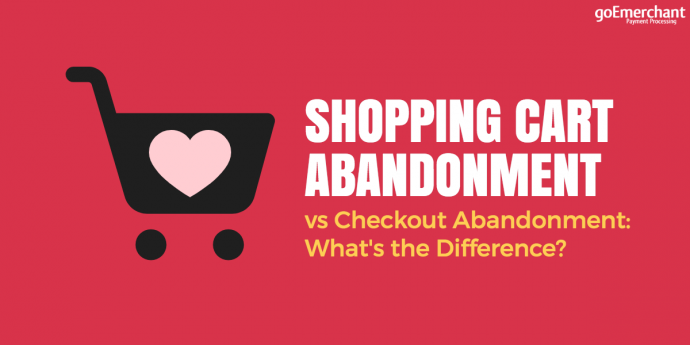Regardless of why a customer abandons a purchase plan, this is a costly, and frustrating problem for merchants. The trick is finding proactive solution to overcome both cart and checkout abandonment.
While the concept of cart abandonment and checkout abandonment are often used interchangeably, there is a difference between the two terms. Although subtle, the distinction is vital for merchants wanting to execute strategies to help overcome customer churn and boost sales.
What is Cart Abandonment?
Cart abandonment is estimated to be a $4.6 trillion problem that significantly hinders merchants’ bottom lines. Cart abandonment occurs when a shopper adds an item to a cart and leaves that site before engaging with the checkout experience. Industry estimates cart abandonment to be somewhere between 70-80%, which is why merchants are so focused on tackling this problem.
What usually leads to cart abandonment is clunky site navigation, long load times for pages, sites that aren’t mobile responsive, and making it too difficult to navigate between product pages and a merchant’s checkout page. Shopping cart abandonment is also a common issue for all eCommerce merchants simply because many shoppers come to a site to browse items, and aren’t ready to buy just yet. That leaves them putting items in a cart for later.
The problem? Many of those browsers never actually convert to buyers, which is why cart abandonment rates continue to be a consistent problem for merchants of all sizes. Luckily, there are cart abandonment recovery solutions that can help merchants overcome the pitfalls that cause customers to abandon their purchases before the checkout stage.
How to Overcome Cart Abandonment
Unlike the physical store experience, the online shopping relationship can make it a bit harder to connect with your customers. Since shoppers don’t have to engage with actual people, it’s easy for them to add items to a cart, only to abandon them without much thought. In the brick-and-mortar side, this is less likely to happen. Retailers can overcome this disconnect by leveraging eCommerce marketing strategies.
One of those tactics is through retargeting emails that allow you to stay continually connected with your core customers. As we noted above, many customers have intent to buy, but may have been browsing at the time they added items to their cart. Retargeting email is an effective strategy to bring those customers back to your site by reminding them that they once showed interest in a specific product.
These “cart abandonment” email can customize the email message to mention the specific items in their cart that were left behind. This keeps your brand, and products, atop of mind. Since your most loyal customer base has already provided their email to your company, you should continually leverage this tactic and create a better path to purchase.
What is Checkout Abandonment?
Similar to cart abandonment, checkout abandonment occurs at the final stages of a purchase. The customer not only added items to their cart but the engagement with the checkout process to likely convert. There are many common reasons why customers abandon the shopping, but at the top of that list is cost. Other reasons for checkout abandonment include concerns over security, payment errors and a lack of options about how a customer can pay for their purchase.
Unexpected costs are one of the leading reasons that lead to abandoned checkout, and many of them are directly impacted by how a merchant manages their checkout process. For example, some merchants don’t show the cost of tax and shipping until the last checkout page, which can cause add friction into the final buying process. Unforeseen expenses are correlated with a lack of transparency and can lead to increased churn.
Checkout abandonment is an especially worrisome problem for merchants because this is a category of customers who likely had strong buyer’s intent, but dropped their purchase in the final stages due to many factors the merchant could have probably overcome.
How to Overcome Checkout Abandonment
The best way to avoid customer abandoning their carts is to provide a seamless, transparent customer experience. From the moment your customer engages with the checkout process, it should be quick and easy for them to pay for their desired items. This means avoiding tacking on last-minute charges, being transparent about purchasing terms and reducing friction points.
Instead of forcing a customer to fill out lengthy forms that lead to increased churn, merchants should leverage checkout options that allow for faster checkout. Payment methods that enable a one-click buying button are one method to help address this. Merchants should also allow customers to checkout faster, and without a requirement to have an account at checkout. Allowing them to pay on their terms, and as a guest, puts the shopper in control of their personal experience. This empowers them to complete their purchase.
Unlike the brick-and-mortar shopping process, customers need to be guided through the online checkout experience. In today’s digital-first ecosystem, merchants must realize that customers are impatient and expect them to provide a simplified site that is easy to navigate. This includes the process it takes to add an item to a cart, and then finalize that purchase.
Regardless if you are a merchant attempting to overcome cart abandonment or checkout abandonment, the strategies are interrelated. To tackle customer churn, merchants must have plans to keep customers engaged on-site from the first interaction point to the checkout stage. Encouraging shoppers to convert is an ongoing process for merchants that can’t be put on the backburner. Luckily, executing a strategy avoid cart abandonment and checkout abandonment can be done with the right partner by your side.




